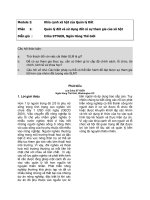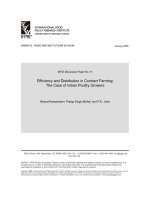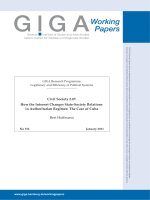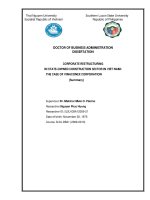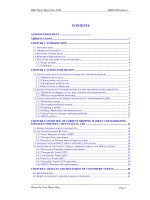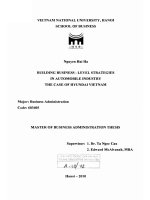Measuring brand equity index in paper industry the case of double a international network company limited
Bạn đang xem bản rút gọn của tài liệu. Xem và tải ngay bản đầy đủ của tài liệu tại đây (3.34 MB, 138 trang )
MEASURING BRAND EQUITY INDEX IN PAPER INDUSTRY – THE CASE
OF DOUBLE A INTERNATIONAL NETWORK COMPANY LIMITED
In Partial Fulfillment of the Requirements for the Degree of
MASTER OF BUSINESS ADMINISTRATION
In Marketing
By
Ms: Nguyen Ly Ai Vy
ID: MBA04049
International University - Vietnam National University HCM
August 2013
i
MEASURING BRAND EQUITY INDEX IN PAPER INDUSTRY – THE CASE
OF DOUBLE A INTERNATIONAL NETWORK COMPANY LIMITED
In Partial Fulfillment of the Requirements for the Degree of
MASTER OF BUSINESS ADMINISTRATION
In Marketing
By
Ms: Nguyen Ly Ai Vy
ID: MBA04049
International University - Vietnam National University HCMC
August 2013
Under the guidance and approval of the committee, and approved by all its members,
this thesis has been accepted in partial fulfillment of the requirements for the degree.
Approved:
---------------------------------------------Chairperson
--------------------------------------------Committee member
--------------------------------------------Committee member
--------------------------------------------Committee member
--------------------------------------------Committee member
--------------------------------------------Committee member
ii
Acknowledge
This Master thesis was possible with a fruitful collaboration of all people who
have contributed with a great willingness and devotion to this study.
First of all, I would like to grant our honor to my advisor Dr. Pham Hong Hoa
for her guidance and kind cooperation. Her valuable comment with her vast
knowledge and assistance has developed my research in an appropriate way.
I am grateful to my friends: Ms.Tu Tran, Ms. Linh Nguyen, Mr. Hai Hoang,
Mr. Nho Lu, Ms Chinh Do and those people that I cannot list out here, for assisting
me in finding and introducing me with potential respondents. Their enthusiasm and
supports help me so much in the data collection part of this thesis.
I also want to say thank you to my friends for assisting me in finding and
introducing to me with potential respondents. Their supports help me a lot in finishing
this paper
Finally, my deep gratitude to my beloved Parents for their eternal love,
enduring encouragement and great sacrifice to raise me up to be a mature person
today. To them I dedicate this thesis
Hochiminh, Aug 2013
i
Plagiarism Statements
I would like to declare that, apart from the acknowledged references, this
thesis either does not use language, ideas, or other original material from anyone; or
has not been previously submitted to any other educational and research programs or
institutions. I fully understand that any writings in this thesis contradicted to the above
statement will automatically lead to the rejection from the MBA program at the
International University – Vietnam National University Hochiminh City.
ii
Copyright Statement
This copy of the thesis has been supplied on condition that anyone who
consults it is understood to recognize that its copyright rests with its author and that
no quotation from the thesis and no information derived from it may be published
without the author’s prior consent.
© Nguyen Ly Ai Vy/ MBA04049/2011-2013
iii
Table of Contents
CHAPTER ONE - INTRODUCTION .......................................................................1
1.
Background of study ..........................................................................................1
2.
Problem discussion ............................................................................................2
3.
Research Objective: This study aims to:............................................................5
4.
Research question ..............................................................................................5
5.
Research Scope ..................................................................................................5
6.
Managerial implications.....................................................................................5
7.
Structure of the research ....................................................................................6
CHAPTER 2- LITERATURE REVIEW ..................................................................8
1.
2.
Brand building theory ........................................................................................8
1. 1.
Brand concept ..........................................................................................8
1. 2.
Brand equity definition ............................................................................9
1. 3.
Importance of brand equity......................................................................9
Approaches to measuring brand equity............................................................11
2. 1.
2. 1. 1.
Product market level.......................................................................11
2. 1. 2.
Financial market level ....................................................................12
2. 1. 3.
Customer mindset level: .................................................................13
2. 2.
3.
4.
Three levels to measure brand equity ....................................................11
Measures related to customer mindset...................................................14
Models of brand equity ....................................................................................17
3. 1.
Brand awareness ....................................................................................17
3. 2.
Brand association ...................................................................................17
3. 3.
Appreciation of quality ..........................................................................18
3. 4.
Brand loyalty..........................................................................................18
Formula to measure general brand equity........................................................19
CHAPTER 3- RESEARCH METHOD ...................................................................20
1.
Conceptual framework:....................................................................................20
2.
Research process..............................................................................................21
3.
Measurement design ........................................................................................23
4.
Questionnaire design........................................................................................24
4. 1.
First draft................................................................................................24
4. 2.
Pilot study ..............................................................................................29
4. 3.
Final study..............................................................................................29
5.
Data collection method ....................................................................................29
6.
Data analysis method .......................................................................................32
iv
7.
Validity and reliability .....................................................................................33
CHAPTER 4- PAPER INDUSTRY OVERVIEW AND RELEVANT
COMPETITORS........................................................................................................35
1.
Paper industry overview ..................................................................................35
2. Overview about Double A International Network Company- Ho Chi Minh
branch (DINVN-HCM)............................................................................................36
3.
2. 1.
Double A history and background. ........................................................36
2. 2.
Product available in Vietnam.................................................................38
2. 3.
Profiled market share .............................................................................39
Review of relevant competitors. ......................................................................41
CHAPTER 5- DATA ANALYSIS AND DISCUSSION .........................................45
1. SAMPLE DEMOGRAPHIC OVERVIEW: General looks on personal
information of sample responder as well as response rate.......................................45
2.
3.
4.
5.
RELIABILITY TEST: .....................................................................................47
2. 1.
Reliability test of Double A ...................................................................48
2. 2.
Reliability test of Paper One ..................................................................48
OVERALL BRAND EQUITY ........................................................................49
3. 1.
Overall brand awareness. .......................................................................49
3. 2.
Overall brand association.......................................................................51
3. 3.
Overall perceived value .........................................................................53
3. 4.
Overall brand loyalty .............................................................................54
Purchasing habit...............................................................................................58
4. 1.
Normal usage grammage and number of reams per month ...................58
4. 2.
Criteria to choose a copy paper..............................................................60
4. 3.
Current usage and changing ratio ..........................................................61
Compare with previous research- Specialize in brand equity..........................62
5. 1.
Overall brand equity ..............................................................................63
5. 2.
Changing in purchasing habits...............................................................66
5. 2. 1.
Normal usage grammage ................................................................66
5. 2. 2.
Criteria to chose copy paper ...........................................................67
CHAPTER 6 - CONCLUSION AND RECOMMENDATION .............................68
1.
Research summary:..........................................................................................68
2.
Recommendation .............................................................................................73
2. 1.
Foundation of recommendation .............................................................73
2. 2.
Recommendation for Double A’s brand equity .....................................75
2. 2. 1.
Double A’s brand awareness and brand association ......................76
2. 2. 1. 1 Advertising .................................................................................77
2. 2. 1. 2 Sale promotion ...........................................................................79
v
2. 2. 1. 3 PR ...............................................................................................81
2. 2. 1. 4 Internet marketing ......................................................................82
2. 2. 2.
Double A’s perceived quality .........................................................83
2. 2. 3.
Double A’s brand loyalty ...............................................................83
2. 3.
3.
Recommendation for some other finding ..............................................84
2. 3. 1.
Double A’s price strategy ...............................................................84
2. 3. 2.
Double A’s product ........................................................................85
2. 3. 3.
Double A’s distribution strategy.....................................................86
Limitation and future research recommendation .............................................87
References...................................................................................................................88
Appendix.....................................................................................................................93
vi
List of Tables
Table 1- Sale summary in year 2005 to 2012 ................................................................3
Table 2- List of sum variables and variables ...............................................................23
Table 3- Questionnaire for paper purchaser.................................................................26
Table 4- Questionnaire distribution for paper purchaser .............................................31
Table 5- Key copy paper brands (80sgm) in high price segment ................................42
Table 6- Market share of 80gsm brands ......................................................................44
Table 7- Reliability test for Double A’s brand in 3 groups- brand association,
perceived value, and brand loyalty ..............................................................................48
Table 8- Reliability test for Paper One’s brand in 3 groups- brand association,
perceived value, and brand loyalty ..............................................................................49
Table 9- Mean difference of brand association between two brands: Double A, and
Paper One.....................................................................................................................52
Table 10 - Mean difference of perceived quality between two brands - Double A, and
Paper One.....................................................................................................................54
Table 11- Mean difference of brand loyalty between two brands- Double A and Paper
One...............................................................................................................................56
Table 12- Measure brand equity of four brands: Double A, and Paper One ...............57
Table 13- Compare brand equity of Double A, and Paper One between year 2010
and year 2013...............................................................................................................64
Table 14 - Summary of Double A’s brand equity........................................................69
Table 15- Summary and compare brand equity of Double A, and Paper One ............71
Table 16 - TVC plan detail on HTV ............................................................................78
Table 17- Summary detail of other advertising type ...................................................78
Table 18 - Summary mechanic of sale promotion for each channel............................80
Table 19 - Summary of schedule of IMC program......................................................82
vii
List of Figures
Figure 1- Sale summary in year 2005 to 2012...............................................................4
Figure 2 - Brand equity by Aaker (1991).....................................................................19
Figure 3- IMC mix without rigid disciplinary boundaries..........Error! Bookmark not
defined.
Figure 4- Research model (Adapted from Aaker, 1999) .............................................20
Figure 6- Profiled market share ..................................................................................40
Figure 7- Ho Chi Minh distribution territory...............................................................41
Figure 8 - Product positioning ....................................................................................43
Figure 9 - Education profile.........................................................................................46
Figure 10 - Gender profile ...........................................................................................46
Figure 11- Position profile ...........................................................................................47
Figure 12- Company profile.........................................................................................47
Figure 13- Brand awareness of paper ..........................................................................49
Figure 14 - Measure brand equity of Double A, and Paper One .................................57
Figure 15 - Type of grammage, Demand using paper and the type of grammage vs.
Demand using paper ....................................................................................................59
Figure 16 - 3 top criteria when choosing a new copy paper brand ..............................60
Figure 17 - Current usage and changing ratio..............................................................61
Figure 18: Double A’s brand equity as Aaker model ..................................................70
Figure 19- Summary finding and recommendation .....................................................74
Figure 20 - The objective for various promotion elements..........................................77
viii
ABBREVIATION
1. DINVN- HCM: Double A International Network Company – Ho Chi Minh
branch
2. DA : Double A
3. CR: Corporate reseller
4. DACC: Double A Copy Center
5. IMC: Integrated marketing communication
6. TOM: Top of mind
7. MT: Modern trade
8. GRP: Gross rating point
ix
DEFINITION OF TERMS
1.
Cut-size paper: The small sizes of paper generally used by quick printers as
well as desktop printers are called cut sizes. Paper products are cut into standard sizes
including: A4, A3, B4, B5, F14, F4,… Two common cut sizes are 8.5x11 (letter size)
or A4 and 11x17 (tabloid) or A3. Most of laser printers, photocopy machines, fax
machines, and small presses are designed for the letter size sheets or cut sizes no
larger than the 11x17 or A3 sizes. These common cut sizes are often sold by the ream
in office supply stores. (Retrieved Aug 10, 2012, from The New York Times company,
/>Copy papers: within the limitation of company’s term, copy papers means the
2.
cut-size papers which common use for office such as: photocopy, printing, fax...
3.
Corporate end-users: as the classification of Double A company, corporate
end-users are end-users which are offices.
4.
Corporate resellers: as the classification of Double A company, corporate
resellers are the traders who have 65% of sales volume sold to corporate end-users
directly.
Converted paper: within the limitation of copy paper and the classification of
5.
Double A company, some operations buy folio (big size roll of paper) and do cutting
in size A4 & A3, then do packaging with their owned brand name. These operations
don’t have the mill to produce paper.
6.
Modern trade: Modern trade as opposed to traditional retail shops refers to a
full range of sales methods based on marketing techniques: for instance in self-service
shops you have no more sales attendants behind a counter: now the customer can
touch the articles. As Double company’s classification: modern trade includes
hypermarkets, supermarkets, mini-supermarkets and bookstores.
(Retrieved Aug 10, 2012, from Answers website:
/>7. Recycled based paper: paper which is produced from recycled paper material.
8. Ream: packaging unit of copy paper. A common ream includes 500 paper sheets.
9.
Traditional trade: as the classification of Double A company, traditional trade
is intermediary channels which include wholesaler, retailers & photocopy shops (copy
centers).
x
Abstract
Powerful brands create meaningful images in the minds of customers (Keller,
1993), with brand image and reputation enhancing differentiation and having a
positive influence on buying behavior (Gordon et al., 1993; McEnally and de
Chernatony, 1999). Branding in consumer markets can improve financial performance
and long-term competitive position (Mudambi, 2002).
The study attempts to measure brand awareness, brand associations, perceived
value, and brand loyalty of Double A and its key competitor- Paper One. Moreover,
comparing brand equity scores of Double A and Paper One for current year and year
2010 to evaluate performance of the brand. This study aims to contribute to the
concrete importance of brand equity management in the paper industry especially by
illustrating real analysis and empirical cases of two paper brands- Double A, and
Paper One- in Ho Chi Minh market, to adjust brand strategy and improve Double A’s
brand performance.
Based on a quantitative survey, consumer’s brand knowledge is examined to
confirm the brand value added by these brand equity assets. The survey was
conducted by purposive and snowball method which distributed to 216 target
respondents at these big offices in Ho Chi Minh City. The target respondents must be
the main decision maker or involved partially in purchase stationary at their company
will be qualified.
Data analysis has brought the results that Double A’s brand equity get a higher
mean score than Paper One in most of brand attributes, except brand association.
However, in comparing with the brand equity score in year 2010, Double A’s brand
equity in this year was worse than the past while Paper One’s brand performance was
better in most of attributes in comparison with current year.
xi
The important of brand strategy and data results have shown that Double A
need to adjust and improve its brand strategy. An integrated marketing
communication strategy was proposed to improve both four brand attributes of
Double A.
A clear view of the current brand position will help Double A International
network company (DINVN) understand about its situation, to propose a better plan to
adjust its brand strategy so that the brand performance can improve year by year.
Keywords: Paper industry, Brand, Brand equity, Brand awareness, Brand association,
Perceived value, Brand loyalty, Double A, Paper One.
xii
This page is intentionally left blank
xiii
CHAPTER 1 - INTRODUCTION
This chapter will start with a presentation about the subject as to be followed by a
research problem. The research problem aims to give the reader a better understanding
about the problem area and is a base for the purpose and research questions within this
thesis. The chapter ends with an overall purpose, research questions and a description of
the thesis outline.
1. Background of study
One of the challenges that brand managers face is to justify the efficacy of brand
7management activities in performance metrics that are interpretable and comprehensible
by firm executives. In particular, practitioners are under increasing pressure to justify the
effectiveness of brand investments. According to Rust and colleagues (2004, P.76) , the
concern about “this lack of accountability has undermined marketers’ credibility,
threatened the standing of the marketing function within the firm, and even threatened
marketing’s existence as a distinct capability within the firm.” have raised. For the
importance of this need, numerous studies discover the links between the brand equity
and firm financial metrics (e.g. Aaker and Jacobson 1994, 2001; Mizik and Jacobson
2008; Rego, Billet and Morgan 2009). This stream of research reached the consensus that
brand equity does 1) provide advantages for marketing program, and 2) relate positively
to firm performance.
With these recent advancements in the knowledge of brand equity, there are two
needs emerge to address the essential but unanswered questions about how exactly the
customer mindset (i.e. Brand knowledge) are converted to firm performance. First, we
need to know how the improved customer state of mind lifts firm financial performance
1
through the “customer mindset-market performance-financial performance” chain (Keller
and Lehmann 2003, 2006). Beyond knowing merely that there exists a positive
association, brand managers and firm executives are eager to know in more detail how
improved brand equity is converted to brand market performance, which in turn drives
firm financial performance. This expanded knowledge will facilitate the use of brand and
marketing strategies to optimize return on investment. The second issue is the dearth of
empirical evidence supporting the link between brand equity and brand market
performance. This is an axiom of the brand equity theory with limited empirical
validation.
2. Problem discussion
Managers and academics are increasingly interested in understanding the linkages
between resources deployed in developing marketing assets (such as brands and customer
relationships) and the firm’s market effectively (e.g., Share and margin gains) (Vorhies
and Morgan 2003) and financial performance (Rust et al. 2004). From this perspective,
the marketing literature provides a well-developed theoretical rationale (Keller 1993;
Srivastava, Shervani and Fahey 1998) and a growing body of empirical evidences (Barth
et al. 1998; Madden, fuel, and Fournier 2006; Rao, Agarwal and Dahlhoff 2004) linking
brands with competitive advantage for the firms that own them. As a result, it is
increasingly and widely accepted that brands are important intangible assets that can
significantly contribute to firm performance (Ailawadi, Lehman, and Neslin 2003;
Capron and Hulland 1999; Sullivan 1998). Among the most important findings from this
stream of research is the fact that brand equity is one of the most important determinants
of brand retail performance (Ailawadi, Lehman and Neslin 2003; Keller 2003).
2
With the 2008 global recession, corporate profits have declined that has resulted from
less consumer spending. Unemployment increased, and many who continued as
employed earned less income. Between 2007 and 2009, household income declined 4.1
percent (Brackey, Williams, & Maines, 2010). These consequences make customers
become more price-sensitive, so they have switched to discount, low-priced retail stores.
On average, from 2007 to 2010, they cut spending 55% on entertainment & drinking out,
27% on home appliances and 19% of household utilities. “They also spent less on some
groceries, cutting back on items such as fresh milk and cream, as well as seafood”
(Retrieved from TNS research report, 2011).
For that Double A International Network Company – Viet Nam (DINVN) has
problem with company sales performance. Starting to export paper product at Vietnam in
2003 and officially start up representative office in 2005. At the beginning time, Double
A’s sales performance was very good; the sales performance steadily increases from 10
to 20% each year (Country management report of DINVN). However, in recent year,
during 3 nearly years (from 2010 to 2012), sales performance has dropped continuously.
The following chart shows the sales performance in each year (from 2005 to 2012),
which is provided by Double A Country Management report:
Table 1- Sale summary in year 2005 to 2012
Sales volume (MTs)
Areas
HCM city
and Southern
provinces
2005
2006
2007
2008
2009
2010
2011
2012
2013
(Expect)
798
1298
1890
3063
5078
4750
4043
4021
5000
Market
share
(total copy
paper)
Market
share
(80gsm)
6%
24%
(Retrieved March 15, from Country Management Report of DINVN)
3
Figure 1- Sale summary in year 2005 to 2012
Last estimates
Looking at the chart, we can see the volume of Double A paper has tended to
decrease. Comparing with a sales target from the board of management, Sales
performance of the Double A just meet 90%, lower 10% for expectation. In reality,
together with the current Vietnam economy that can be the problem of competition or
decreasing in demand due to recession of the economy or it can be problematic from
weakening in brand equity. A various questions were listed out to find out the reason for
a current situation which comes from both internal and external reasons. Base on
marketing perspective, the position of Double A brand in customer mind or Double A
brand performance can be a reason for the decreasing in sale performance because when
Double A cannot maintain its position in customer mind, or its brand performance is not
good as the past, customers was forgot about its name or they don’t remember about
these competitive advantages of Double A anymore, instead they remember Double A’s
competitor brand name, Double A’s competitor advantages and their value. Therefore,
4
recognizing this hard circumstance in doing business, a research study is conducted to
study on brand equity and brand market performance to adjust and improve brand
performance.
3. Research Objective: This study aims to:
RO 1: To evaluate current company’s brand equity.
RO 2: To compare with current competitors’ brand equity
RO 3: To find out the solution for the company to improve brand performance in
the next year.
4. Research question
Based on Research Objectives, we have 2 main research questions (RQ) are:
RQ1: What is the current brand equity of the Double A company?
RQ2: How about competitors’ brand equity in comparing with Double A?
RQ3: How to improve brand performance of Double A?
5. Research Scope
The research studies the brand equity of the Double A International Network
Company, Ho Chi Minh branch in comparison with brand performance of Double A’s
key competitors – Paper One to measure, evaluate and adjust to improve Double A’s
brand performance. This research is conducted in the scale within Ho Chi Minh City
geographically; therefore, it cannot represent for the performance of Double A and
expectation of all consumers in Vietnam.
6. Managerial implications
For DINVN: a success of this study will help managers of the company
understand in their current brand position in Ho Chi Minh market in compare with their
5
key competitor. From that company will have clearer view about current situation, adjust
brand strategy and improve brand performance.
7. Structure of the research
The outline of this thesis will be divided into five chapters, which start broad and go
deeper into the problem and research questions
Chapter 1: is the Introduction that will provide a background and
understanding of the chosen subject. This chapter also includes the problem
discussion and describes the purpose of the thesis as well as the research questions
Chapter 2: is the Literature Review which aims to show how this essay
supplement previous studies within the chosen area. The chapter will describe and
explain which hypothesis our research will test
Chapter 3: Methodology. The hypothesis will lead to our research approach,
strategy and the chosen data collection methods. The focus here will be to explain the
different methods are suitable. Here the reader also can get an opinion about the
validity and reliability
Chapter 4: Paper industry overview and relevant competitors: Describe
general about paper industry and it current situation. Moreover, overview about
Double A’s background and its competitor.
Chapter 5: Result & Discussion, this chapter will analyze the collected data
and answer the research questions
Chapter 6: Conclusion will be based on my thoughts and will with that
contribute with recommendations for future practice.
6
The next chapter will cover previous studies related to this thesis filed and show
which hypothesis is used to get the research problems into deeper and state clearer.
7
CHAPTER 2- LITERATURE REVIEW
This chapter is a principal base for the thesis study as it supports the research
purpose by relevant concepts, theories and models. With available literatures, CBBE
framework has conceptualized in a scientist’s base and has narrated with consumer
behavior process at a firm’s level.
1. Brand building theory
1. 1.
Brand concept
In an ideal world the customers choose between different products and services
considering a long list of criteria including product features, pricing, availability and
flexibility. However, when several companies’ products and services are almost similar,
the choices go down to the reputation of the respective brands. The current interest in the
existing brands is more because of the escalating costs of developing new brands, which
has led to the prevalent usage of existing brands by way of brand extension (Tauber,
1988). According to the American Marketing Association (1995), a brand is “a name,
term, sign, symbol or a combination of them, intended to identify the goods and services
of one seller or a group of sellers and to differentiate them from their competitors”.
Farquhar (1989) has defined brand equity as an intangible asset that depends on the
association made by the consumers. However, none of these definitions take into account
the contribution / effect of the brand on middlemen. This gap in definition has been
bridged by Frederick E. Webster Jr. He defined brand as a guarantee of consistent
features, quality and performance to the consumers and is also a pledge of support to the
middlemen (Frederick E. Webstar, Jr., 2000).
8
1. 2.
Brand equity definition
Numerous definitions of brand equity have been proposed by different authors.
According to Aaker (1991), brand equity is the set of assets and liabilities linked to a
brand that add to or subtract from its value to the consumers and business, while Farquhar
(1989) defines brand equity as the monetary value added by the brand to the product.
Swait et al (1993) defines brand equity as the consumer’s implicit valuation of the brand
in a market with differentiated brands relative to a market with no brand differentiation,
whilst Srinivasan, Chan Su Park and Dae Ryun Chang define brand equity as the
incremental contribution (in $) per year obtained by the brand in comparison to the
underlying product or service with no brand building efforts (March 2005). This
incremental contribution is driven by the individual customer’s incremental choice
probability for the brand in comparison to his or her choice probability for the product
with no brand building efforts. From a behavioral viewpoint, brand equity is critically
important to make points of differentiation leading to competitive advantages based on
non price competition (Aaker, 1991). Somewhat paradoxically, the phenomenon labeled
as brand equity from the perspective of a marketing manager corresponds closely to the
state of affairs that economists concerned with social welfare label as ‘market
inefficiency’.
1. 3.
Importance of brand equity
Brand’s equity reflects the value that the brand offers to consumers (Aaker 2004;
Berthon, Hulbert, and Pitt 1999; Lane and Jacobson 1995). It is believed generally that
brands with high levels of equity are associated with superior performance including
sustained price premiums, inelastic price sensitivity, high market shares, a successful
9
expansion into new categories, competitive cost structures and higher profitability (Keller
and Lehmann 2003). The marketing literature provides a large number of cases that
suggest strong brands have both.
It is generally believed that superior brand knowledge (awareness, associations,
attitudes, attachment, etc.) provides a brand with a competitive advantage over other
products in terms of market performance (Hoch 1996; Hoch, Montgomery and Park
2003; Steiner 2004). The value created in consumer’s mind alters purchasing behavior in
favor of the brand by facilitating product identification, reducing search costs, and
eliciting repeat purchase (Berthon et al. 1999; Keller 2003). These changes create loyal
consumers who are inclined to avoid brand-related information search, neglect the
marketing efforts of rivals, consider and re-buy only that brand, and eventually reduce the
“churn” among the brand’s customer base (e.g. Newman and Werbel 1973; Oliver 1997).
This may be particularly relevant for low involvement purchase decisions such as
frequently purchased consumer packaged goods (e.g., Hoyer and Brown 1990). The
series of empirical findings corroborated the argument that strong brands (e.g. Products
with superior quality and high prices) are more rewarded by their marketing actions (e.g.
Pricing, sales promotion, personal selling, etc.) than lower quality competitors (Blattberg
and Wisniewski 1989; Sethuraman 1996; Cotterill and Putsis 2000). In particular, cross
promotional effects are asymmetric and promoting higher quality brands impacts weaker
brands (and private label products) disproportionately (e.g. Allenby and Rossi 1991;
Blattberg and Wisniewski 1989; Krishnamurthi and Raj 1988, 1991). Accordingly,
promoting strong brands generates more switching than is promoting weaker brands (e.g.
Kamakura and Russell 1989). Moreover, higher market share brands are less deal elastic
10
